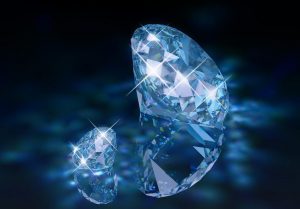Chrysoberyl occurs in a variety of colours, from green, greenish yellow, and yellow to brown. It is a hard, durable stone, particularly suitable for use in jewellery. When cut well, gems are brilliant but lack fire. Two varieties, alexandrite and cat’s-eye, have unique qualities of their own. The very rare and valuable alexandrite changes from green in daylight to red, mauve, or brown under incandescent light, such as a light bulb. Synthetic chrysoberyl, synthetic corundum, and synthetic spinel have all been produced to imitate alexandrite’s colour change.
Cat’s-eye, when cut in cabochon, has a near-white line across a yellowish grey stone, due to canal or feather-like fluid inclusions, or needle-like inclusions of rutile. The most highly prized cat’s-eye color is a light golden brown, often with a shadow that gives a light and dark, “milk and honey” effect. Pale yellow chrysoberyl, popular in 18th and 19th century Portuguese jewellery, was also knonwn as chrysolite.
Although mainly worked out, the best chrysoberyl, including alexandrite, has been discovered in mica schists in the Urals (Russia). The largest faceted chrysoberyl from Russia weighs 66 carats. Large waterworn pebbles of various colors are found in the gem gravels of Sri Lanka. Chrysoberyl also occurs in Burma, Brazil, Zimbabwe, Tanzania and Madagascar. Cat’s eye is found in Sri Lanka, Brazil and China.
The name is from the Greek “chrysos”, meaning golden and “beryllos” which refers to the beryllium content. Known for centuries in Asia, it was highly valued for the protection it afforded from the “evil eye”.



























Leave a Reply
You must be logged in to post a comment.